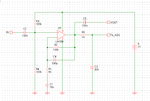ha9981
Newbie level 4
I have the following Microphone: CZ034GU
Sensitivity -47 +- 4dB
Low Impedance
Current Consumption 500uA
Standard Operation Voltage 1.5V
S/N ratio more than 58dB
**broken link removed**
I have seen that to get this to input into any amplifier it needs Vin connected to output pin with a resistor followed by capacitor in series before input into the amplifier.
I found some sample circuits:
http://www.inexglobal.com/downloads/ZX-sound_e.pdf
http://fritzing.org/projects/electret-mic-opamp/
http://www.sparkfun.com/datasheets/BreakoutBoards/Amplified-Mic-Electret-v14.pdf
But I am still confused. I need to have a LPF as I will be using this to sample audio. It is to interface to microcontroller A2D. I need an output range of 0v to 5v, but what gain do I need I have no idea, I cannot find spec on microphone output range.
Where do I start?
here are some op-amps I found:
TLC272
LM386
TL071
OPA344
Also what is a good LPF filter for audio fc = 4khz because fs = 8khz.
Here is some info I found on active LPF circuits.
I am in a bit of a hurry as electronics store for Op-Amp is only open saturday and then on tuesday. If you had to pick an op-amp for audio which would it be?
Sensitivity -47 +- 4dB
Low Impedance
Current Consumption 500uA
Standard Operation Voltage 1.5V
S/N ratio more than 58dB
**broken link removed**
I have seen that to get this to input into any amplifier it needs Vin connected to output pin with a resistor followed by capacitor in series before input into the amplifier.
I found some sample circuits:
http://www.inexglobal.com/downloads/ZX-sound_e.pdf
http://fritzing.org/projects/electret-mic-opamp/
http://www.sparkfun.com/datasheets/BreakoutBoards/Amplified-Mic-Electret-v14.pdf
But I am still confused. I need to have a LPF as I will be using this to sample audio. It is to interface to microcontroller A2D. I need an output range of 0v to 5v, but what gain do I need I have no idea, I cannot find spec on microphone output range.
Where do I start?
here are some op-amps I found:
TLC272
LM386
TL071
OPA344
Also what is a good LPF filter for audio fc = 4khz because fs = 8khz.
Here is some info I found on active LPF circuits.
I am in a bit of a hurry as electronics store for Op-Amp is only open saturday and then on tuesday. If you had to pick an op-amp for audio which would it be?



